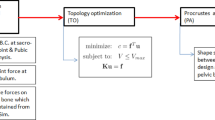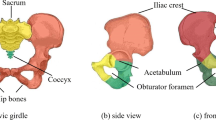Abstract
Pelvic bone is a complex and robust load-bearing skeletal structure in the human body, the evolution of which might have been influenced by mechanical loads of daily activities like walking, upright standing, and running. Since the main function of skeletal bones is to provide rigidity to the body and provide hard surfaces for muscle attachment as well, in this work we propose a compliance minimization problem to determine whether material distribution guided by topology optimization yields a skeletal structure similar to the pelvic bone under same boundary conditions and volumetric constraints. As bone growth occurs in response to the mechanical loads acting on it, we consider the maximal loads that the pelvic bone may experience for a continued period of time, namely during running. The running gait cycle is divided into seven phases, and the objective function is a weighted combination of these seven phases. The optimal geometries are compared with the natural hemi-pelvis by measuring shape similarity using Procrustes analysis. Results show that the optimal geometries have good shape similarity in stance phases. We also explore the design space by considering a combination of sequence of phases which is an alternative to the weighted multiple load-case objective function. In all cases, the optimal geometries are stiffer than the hip bone. To validate this result, we conducted compression test experiments on selected optimal geometries and natural hemi-pelvis model of same material and found that the experimental results prove that topology optimization based optimal geometries are indeed more stiff than the natural hemi-pelvis geometry.











Similar content being viewed by others
References
Mellon S J and Tanner K E 2012 Bone and its adaptation to mechanical loading: A review. Int. Mater. Rev. 57(5): 235–255
Turner C H 1998 Three rules for bone adaptation to mechanical stimuli. Bone 23(5): 399–407
Wolff J 1892 The Law of Bone Remodelling. Translated version, 1986, Springer
Cowin S C, Moss-Salentijn L and Moss M L 1991 Candidates for the mechanosensory system in bone. J. Biomech. Eng. 113(2): 191–197
Weinans H, Huiskes R and Grootenboer H J 1992 The behavior of adaptive bone-remodeling simulation models. J. Biomech. 25(12): 1425–1441
Harrigan T P and Hamilton J J 1993 Finite element simulation of adaptive bone remodelling: A stability criterion and a time stepping method. Int. J. Numer. Methods Eng. 36(5): 837–854
Fyhrie D and Schaffler M B 1995 The adaptation of bone apparant density to applied load. J. Biomech. 28(2): 135–146
Levenston M E and Carter D R 1998 An energy dissipation-based model for damage stimulated bone adaptation. J. Biomech. 31(7): 579–586
Ruimerman R, Hilbers P, Van Rietbergen B and Huiskes R 2005 A theoretical framework for strain-related trabecular bone maintenance and adaptation. J. Biomech. 38(4): 931–941
Hollister S J, Kikuchi N and Goldstein S A 1993 Do bone ingrowth processes produce a globally optimized structure? J. Biomech. 26(4–5): 391–407
Fernandes P, Rodrigues H and Jacobs C 1999 A model of bone adaptation using a global optimisation criterion based on the trajectorial theory of Wolff. Comput. Methods Biomech. Biomed. Eng. 2(2): 125–138
Bagge M 2000 A model of bone adaptation as an optimization process. J. Biomech. 33(11): 1349–1357
Fernandes P R, Folgado J, Jacobs C and Pellegrini V 2002 A contact model with ingrowth control for bone remodelling around cementless stems. J. Biomech. 35(2): 167–176
Nowak M 2006 Structural optimization system based on trabecular bone surface adaptation. Struct. Multidiscipl. Optim. 32(3): 241–249
Sutradhar A, Paulino G H, Miller M J and Nguyen T H 2010 Topological optimization for designing patient-specific large craniofacial segmental bone replacements. PNAS 107(30): 13222–13227
Lekszycki T 1999 Optimality conditions in modeling of bone adaptation phenomenon. J. Theor. Appl. Mech. 37(3): 607–624
Lekszycki T 2002 Modelling of bone adaptation based on an optimal response hypothesis. Meccanica 37(4–5): 343–354
Rodrigues H, Jacobs C, Guedes J M and Bendsoe M P 2002 Global and local material optimization models applied to anisotropic bone adaptation. In: Pedersen P, Bendsoe MP (eds) IUTAM Symposium on Synthesis in Bio Solid Mechanics, Springer, Dordrecht, pp. 209–220
Goel V K and Svensson N L 1977 Forces on the pelvis. J. Biomech. 10(3): 195–200
Dostal W F and Andrews J G 1981 A three dimensional Biomechanical model of Hip Musculature. J. Biomech. 14(11): 803–812
Dalstra M, Huiskes R and van Erning L 1995 Development and validation of a three-dimensional finite element model of the pelvic bone. J. Biomech. Eng. 117(3): 272–278
Ghosh R, Pal B, Ghosh D and Gupta S 2015 Finite element analysis of a hemi-pelvis: the effect of inclusion of cartilage layer on acetabular stresses and strain. Comput. Methods Biomech. Biomed. Eng. 18(7): 697–710
Ricci P L, Maas S, Kelm J and Gerich T 2018 Finite element analysis of the pelvis including gait muscle forces: an investigation into the effect of rami fractures on load transmission. J. Exp. Orthop. 5(1): 1–9
Goel V K, Valliappan S and Svensson N L 1978 Stresses in the normal pelvis. Comput. Biol. Med. 8(2): 91–104
Hu P, Wu T, Wang H Z, Qi X Z, Yao J, Cheng X D, Chen W and Zhang Y Z 2017 Influence of different boundary conditions in finite element analysis on pelvic biomechanical load transmission. J. Orthop. Surg. 9(1): 115–122
Kumar K E S and Rakshit S 2020a Topology optimization of the hip bone for gait cycle. Struct. Multidiscipl. Optim. 62(4): 2035–2049
Sutradhar A, Park J, Carrau D, Nguyen T H, Miller M J and Paulino G H 2016 Designing patient-specific 3D printed craniofacial implants using a novel topology optimization method. Med. Biol. Eng. Comput. 54(7): 1123–1135
Mei J, Ni M, Gao Y S and Wang Z Y 2014 Femur performed better than tibia in autologous transplantation during hemipelvis reconstruction. World J. Surg. Oncol. 12(1): 2–7
Wang B, Xie X, Yin J, Zou C, Wang J, Huang G, Wang Y and Shen J 2015 Reconstruction with modular hemipelvic endoprosthesis after pelvic tumor resection: A report of 50 consecutive cases. PLoS ONE 10(5): 1–11
Simonsen E B, Thomsen L and Klausen K 1985 Activity of mono- and biarticular leg muscles during sprint running. Eur. J. Appl. Physiol. 54(5): 524–532
Nilsson J and Thorstensson A 1989 Ground reaction forces at different speeds of human walking and running. Acta Physiol. Scand. 136: 217–227
Schache A G, Blanch P, Rath D, Wrigley T and Bennell K 2002 Three-dimensional angular kinematics of the lumbar spine and pelvis during running. Hum. Mov. Sci. 21: 273–293
Bendsoe M P and Sigmund O 2004 Topology Optimization: Theory, Methods and Applications, 2nd ed. Springer
Sigmund O 2001 A 99 line topology optimization code written in matlab. Struct. Multidiscipl. Optim. 21: 120–127
Park J, Lee D and Sutradhar A 2019 Topology optimization of fixed complete denture framework. Int. J. Numer. Methods Biomed. Eng. 35(6): 1–11
TheMotionMechanic 2019 Wordpress. http://www.themotionmechanic.com/2019/02/20/thebiomechanics-of-running-3-common-technique-faults/
Hamner S R, Seth A and Delp S L 2010 Muscle contributions to propulsion and support during running. J. Biomech. 43(14): 2709–2716
Phillips A T, Villette C C and Modenese L 2015 Femoral bone mesoscale structural architecture prediction using musculoskeletal and finite element modelling. Int. Biomech. 2(1): 43–61
Van Arkel R J, Modenese L, Phillips A T and Jeffers J R 2013 Hip abduction can prevent posterior edge loading of hip replacements. J. Orthop. Res. 31(8): 1172–1179
Cavanagh P R and Lafortune M A 1980 Ground reaction forces in distance running. J. Biomech. 13: 397–406
Novacheck T F 1998 The biomechanics of running. Gait Posture 7(1): 77–95
Geraldes D M, Modenese L and Phillips A T 2016 Consideration of multiple load cases is critical in modelling orthotropic bone adaptation in the femur. Biomech. Model. Mechanobiol. 15(5): 1029–1042
Bendsoe M P and Sigmund O 1999 Material interpolation schemes in topology optimization. Arch. Appl. Mech. 69(9): 635–654
Uri K 1994 Efficient sensitivity analysis for structural optimization. Comput. Methods Appl. Mech. Eng. 117: 143–156
Sigmund O and Petersson J 1998 Numerical instabilities in topology optimization: A survey on procedures dealing with checkerboards, mesh-dependencies and local minima. Struct. Multidiscipl. Optim. 16: 68–75
Bourdin B 2001 Filters in topology optimization. Int. J. Numer. Methods Eng. 50(9): 2143–2158
Anderson A E, Peters C L, Tuttle B D, Weiss J A 2005 Subject-specific finite element model of the pelvis: development, validation and sensitivity studies. J. Biomech. Eng. 127(3): 364–373
Kumar K E S and Rakshit S 2021 Topology optimization of the hip bone for a few activities of daily living. Int. J. Adv. Eng. Sci. Appl. Math. 12(3): 193–210
Kumar K E S and Rakshit S 2020b Topology Optimization of the Pelvic Bone Prosthesis Under Single Leg Stance. In: Volume 11B: ASME-IDETC&CIE, v11BT11A030
Kumar K E S and Rakshit S 2021 Design of pelvic prosthesis using topology optimization for loads in running gait cycle. J. Inst. Eng. (India) C 102(96): 1119–1128
Zhao X, Liu Y, Hua L and Mao H 2016 Finite element analysis and topology optimization of a 12000KN fine blanking press frame. Struct. Multidiscipl. Optim. 54(2): 375–389
Gower J C 1975 Generalized procrustes analysis. Psychometrika 40(1): 33–51
Acknowledgements
The authors thank Prof. C. Sujatha, Department of Mechanical Engineering, IIT Madras, for providing the geometric model of the pelvic bone. Prof. Ratna Kumar Annabattula, Department of Mechanical Engineering, IIT Madras, is gratefully acknowledged for allowing us to conduct experiments on the UTM in Mechanics of Materials lab in Machine Design Section, IIT Madras.
Author information
Authors and Affiliations
Corresponding author
Ethics declarations
Conflict of interest
The authors declare that they have no conflicts of interest.
Rights and permissions
About this article
Cite this article
Kumar, K.E.S., Rakshit, S. Optimization based synthesis of pelvic structure for loads in running gait cycle. Sādhanā 47, 118 (2022). https://doi.org/10.1007/s12046-022-01881-8
Received:
Revised:
Accepted:
Published:
DOI: https://doi.org/10.1007/s12046-022-01881-8




